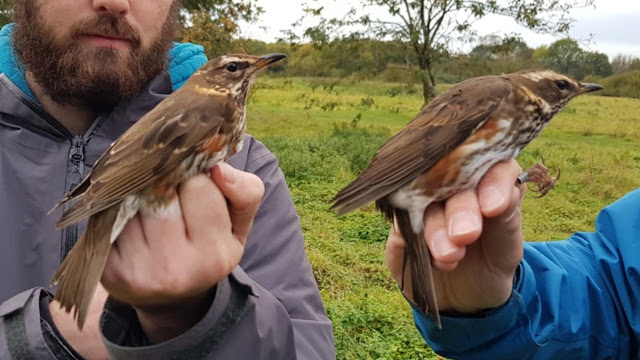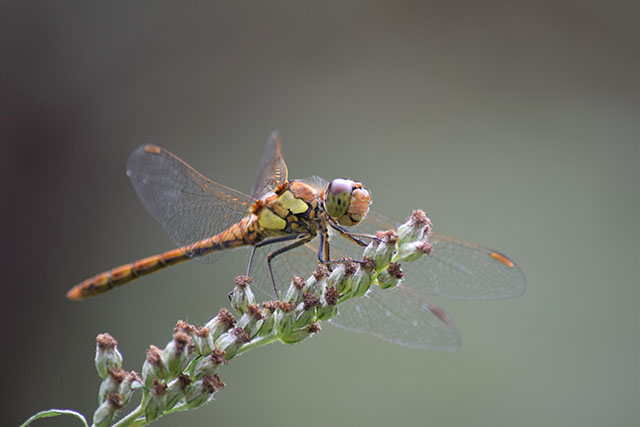It's been a few weeks since the last post which tells you all you need to know about the state of the birding which has been very samey. If we start with the ducks then the usual Wigeon and Teal have been around in more or less the usual numbers (in the December WeBS counts there were 634 and 235 respectively). Goosander counts have fluctated with a peak being 9 birds. These smart sawbills often like to hang out on the river during the day, coming into roost on the floods in the evening. Pintail counts have been up and down as well with half a dozen or so being a typical number. There have been up to 6 Shelduck hanging out as well, usually to be seen in the morning on the floods. Shoveler numbers have been gradually increasing with 36 on the December WeBS. Goose numbers have been steady as well though the Barnacle Geese are often absent these days. A flock of 8 White-fronted Geese were spotted by Elizabeth Stroud flying over the Meadow one day: there has been a national influx of this species recently though these birds were probably actually the usual feral Blenheim ones. An usual record of a Black Swan flying south over the Meadow was noteworthy. Actually, we did have one of these on the river one morning near the Perch recently - these feral birds are not tickable for BOU listing though they seem self-sustaining enough to me. Elizabeth Stroud reported a Little Grebe along the Castle Mill Stream: this used to be a guaranteed spot to see this species in the winter though in recent years they've not been so reliable. In fact this was a year tick!
On the wader front it's been rather slim pickings. There have been Lapwing and Golden Plover about in varying numbers. One time a dog flushed at least 30 Snipe from their hiding places in amongst the tussocks along the shoreline where they are normally invisible. We did have a single Redshank visit us for a few days at the start of the month and Nick Boyd spotted a Ruff on the 2nd but that's been about it.
 |
| Foggy Golden Plover, courtesy of Matthew Lloyd |
Gulling has been improving gradually though numbers in the evening roosts are still rather sporadic, depending largely on the weather. We've had a couple more Caspian Gulls recently, an adult one evening and a 1st winter another. Apart from that we might reasonably get a Yellow-legged Gull each evening if there are a reasonable number of large gulls. We've recently had a noticable uptick in Great Black-backed Gulls over the last week or so.
 |
| Adult Caspian with a strange mark below it's eye, courtesy of Ollie Padget |
 |
| The 1w Caspian Gull courtesey of Thomas Miller |
As far as other birds are concerned, there has been a Grey Wagtail hanging around by Burgess Field gate, a fly-over Ring-necked Parakeet was heard by Ollie Padget, a Peregrine was seen in the Poplars by Mary MacDougall and Nick Boyd reported that a pair of Stonechat are still hanging out in the King's Lock area. Ollie Padget had a close encounter with a Weasel one day over near the Aristotle Lane bridge area.
Finally, I feel that I have to mention the flushing of birds on the Meadow. In the winter it is hard enough as it is for birds to survive. What with reduced hours of daylight and the cold temperatures they have to cram as much feeding as they can into the time that they are awake. For this reason flushing of the birds on the Meadow is a serious matter as they then have to waste energy flying around instead of feeding and it just makes things all the harder for them. Now unfortunately the Meadow is common land open to the public so there is little that can be done about it and thoughtless dog owners allowing their animals to run amuck and flush everything is sadly part and parcel of birding life on the Meadow. However, there have recently been a number of incidents of birders and photographers who have selfishly been going right up to the edge of the shoreline and putting everything up. In the words of one Meadow birder: "these people need to take a long hard look at themselves". The truth is that the Meadow is a difficult site to bird without a scope and it's generally not possible to get very close to the birds without flushing them. However nice it is to see them close up, please be considerate of their welfare and view them or photograph them from reasonable a distance.
 |
| Port Meadow landscape, courtesy of Matthew Lloyd |









































